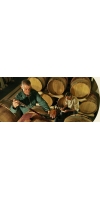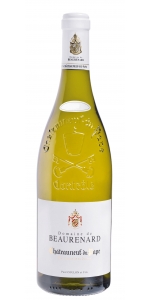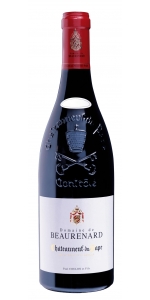Wine from Beaurenard

In the 14th century, during their stays in Avignon, the popes – and especially Pope John XXII – built a papal castle in Châteauneuf-du-Pape. Impressed by the area's exceptional soils, they established vineyards on the slopes surrounding the château and were instrumental in promoting the local wine's reputation around the world.
Domaine de Beaurenard in Châteauneuf-du-Pape has been a family-run estate for seven
generations.
A notarial act dated 16 December 1695 mentions “Bois Renard”, which over time has become “Beaurenard”.
The Coulon brothers, Daniel and Frédéric, have taken over from Paul and Régine and are striving to sustain tradition.
The estate covers 32 hectares (a little under 80 acres) of vines in Châteauneuf-du-Pape and 25 hectares in the Côtes du Rhône Villages Rasteau AOC area.
The pebbles the 13 grape varieties the sun and the Mistral have been joining forces for centuries to give birth to each vintage of the Châteauneuf du Pape appellation. The terroir of Châteauneuf-du-Pape is unique: here the large sun-warmed stones diffuse a gentle, providential heat that helps the grapes to mature and their juice to concentrate. The Domaine is home to the " Symphony of 13 varieties" typical of this AOC, which provide aromatic complexity, strength and balance.
For the red wines, four varieties dominate : Grenache, Syrah, Mourvèdre and Cinsault, supplemented by Counoise, Muscardin, Terret Noir and Vaccarèse. The whites are made from white-grape vines : Clairette, Roussane, Bourboulenc, Grenache Blanc, Picardan and Picpoul.
All of Domaine de Beaurenard's vines (60ha) are cultivated organically (Ecocert certified) and even biodynamically (Demeter certified), without synthetic chemicals. The vines are thus attuned to nature, lunar and planetary cycles, and the rhythms of the cosmos.
At key moments, we apply biodynamic preparations (born dung, dung compost, silica, etc.) that strengthen the vines's natural defences. To further fortify them, plant-tea sprays (nettle,yarrow,horsetail,camomile...) are regularly dispensed. In the vineyatds, these methods involve working the soil without herbicides, spreading carefully-dynamised manure, and maintaining sensible grass cover (according to climatic conditions).
The creation of a conservatory with the 13 grape varieties allowed by the appellation, procured from the estate's oldest vines, also promotes biodiversity. The varieties were selected over a five-year period and splice-grafted in aplot where the soil had been resting for 12 years.In doing this, we aimed primarily to safeguard a natural genetic heritage that is particularly well adapted to the terroir. But we were also mindful of future generations; and of being able, if global warning continues, to increase the proportion of varieties that contain less sugar ( and so less alcohol) and contribute aromatic complexity.
Meticulous work is performed all around the years, and particularly during four intense periods :
Pruning is done solely by the estate staff: each person tends to the same plot over the long term, crafting their vines like sculptures.
Debudding of all the vines: this prevents leaf build-up around the bunches, ensure small yields, and ventilates the vine-trunks by letting natural light through. Several other jobs are also done while the grapes are still unripe: placing the shoots between the trellis wires, to which they are then fastened; and green harvesting if necessary.
Soil-working and controlled grass cover are supplemented by a team of seasonal workers who, during long weeks, hoe between the vines – a very strenuous, painstaking job in our stony soils.
Harvesting with all grapes hand-picked and sorted.
This type of extremely precise cultivation and monitoring means we obtain healthy grapes, the only way to make wines of high-quality and concentration.
Domaine de Beaurenard Chateauneuf-du-Pape Blanc is made from Clairette blanche & Rose, Grenache Blanc & Gris, Bourboulenc, Roussanne, Picpoul and Picardan.
Gold bright green color. Expressive nose with pear and stone fruits aromas (peach, apricot) with jasmine and roasted almonds notes. The mouth is smooth and fleshy like stone fruit we can smell, with a long a nice finish.
Review:
Bright golden yellow, silver reflections. Delicate herbal spices, a hint of chamomile and mandarin zest, pears and blossom honey are underneath. Juicy, elegant, white peach, delicate honeydew melon, mineral and harmonious, fine fruit sweetness, good ripening potential.
-Falstaff 92 Points
Domaine de Beaurenard Chateauneuf-du-Pape is made from 65% Grenache, 15% Syrah, 10% Mourvèdre.
Domaine de Beaurenard’s flagship wine is a quintessential blend, reflecting all the diversity of the terroir and the perfect synergy that exists between the soils and the grapes. It offers a supple and refined texture associated with a delicate aromatic palette that is the result of a constant quest for freshness.
Review:
Checking in as a blend of 65% Grenache, 15% Syrah, 10% Mourvèdre, and the rest a handful of varieties, the 2019 Châteauneuf Du Pape was brought up in a mix of foudre and older barrels. This deep ruby/purple-hued effort has a pure, vibrant, incredibly seamless, medium to full-bodied style that carries classic notes of black raspberry and black cherry fruits as well as peppery herbs, violets, spring flowers, and sous bois. This straight-up gorgeous, seamless, ultra-fine 2019 should be snatched up by readers. It has a rare mix of elegance, purity, and power, and it’s going to have two decades of prime drinking.
-Jeb Dunnuck 95 Points
- back
Selected Options
Wineries
Categories
Pricing
Countries
Regions
Grape Types
Wineries
Organic/Free Shipping
The 2021 Domaine Joseph Voillot Volnay Les Champans Premier Cru is from the domain’s largest premier cru holding, 4.2 acres whose vines date from 1934, 1971, and 1985. Champans is down-slope in the premier cru band, and its wine typically has more fruit and power than other Voillot Volnays.
Review:
‘The 2021 Volnay Les Champans Ter Cru has much more brightness and delineation than the Fremiets this year, with red cherries, wild strawberries and ust a touch of iodine and sous-bois. This is nicely focused. The palate is medium-bodied with sappy red fruit, fine structure, pliant tannins and a harmonious finish. Not the most complex Champans encountered from this address, yet it has class.
-Vinous 91-93 Points
The 2021 les Champans is also a simply stunning example of this fine premier cru vineyard. The beautifully elegant nose wafts from the glass in a blend of red and black plums, cherries, spit-roasted quail, a complex base of soil, woodsmoke, coffee bean and a deft touch of vanillin oak. On the palate the wine is pure, full-bodied and shows off superb depth at the core, great soil signature, ripe, fine-grained tannins and a long, nascently complex and very promising finish. This is a touch more reserved on the palate than the Fremiets and will take a bit longer to blossom, but it is going to be stellar. 2034-2085.
93+ pts- John Gilman, View from the Cellar #102
Kynsi Pinot Noir Edna Valley is made from 100 percent Pinot Noir.
The Edna Valley was one of the first registered appellations in California and boasts a rich agrarian history. The coastal terrain features varied soil types that are predominantly marine in origin, with ancient volcanic influences. The unusual transverse ranges allows the appellation to open up to the cooling breezes of the Pacific Ocean from nearby Morro Bay and Pismo Beach. The climate is strongly influenced by the ocean providing ideal, temperate growing conditions for Pinot Noir. Early spring warming, mild summer temperatures and late arriving cold fall temperatures and rain provide a long growing season for the development of rich color with concentrated and complex flavors.
Aged 16 months in French Oak barrels, 25% new.






